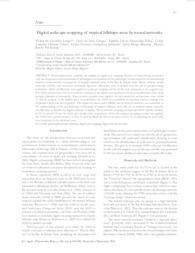Digital soilscape mapping of tropical hillslope areas by neural networks.
Digital soilscape mapping of tropical hillslope areas by neural networks.
Author(s): CARVALHO JUNIOR, W. de; CHAGAS, C. da S.; FERNANDES FILHO, E. I.; VIEIRA, C. A. O.; SCHAEFER, C. E. G.; BHERING, S. B.; FRANCELINO, M. R.
Summary: Geomorphometric variables are applied in digital soil mapping because of their strong correlation with the disposition and distribution of pedological components of the landscapes. In this research, the relationship between environmental components of tropical hillslope areas in the Rio de Janeiro State, Brazil, artificial neural networks (ANN), and maximum likelihood algorithm (MaxLike) were evaluated with the aid of geoprocessing techniques. ANN and MaxLike were applied to soilscape mapping and the results were compared to the original map. The ANN architectures with seven and five neurons in the hidden layer produced the best classifications when using samples obtained systematically. When random samples were applied, the best neural net architectures were within 22 and 16 neurons in the hidden layer. In conclusion, the ANN can contribute to soilscape surveys, making map delineation faster and less expensive. The digital elevation model (DEM) and its derived attributes can contribute to the understanding of the soil-landscape relationship of tropical hillslope areas; the use of artificial neural networks and MaxLike is feasible for digital soilscape mapping. The systematic sampling method provided a global accuracy of 70 % and 65.9 % for the ANN and the MaxLike, respectively. When the random sampling method was applied, the ANN had a global accuracy of 69.6 %, and the MaxLike had an accuracy of 62.1 %, considering the total study area in relation to the reference map.
Publication year: 2011
Types of publication: Journal article
Unit: Embrapa Soils
Observation
Some of Embrapa's publications are published as ePub files. To read them, use or download one of the following free software options to your computer or mobile device. Android: Google Play Books; IOS: iBooks; Windows and Linux: Calibre.
Access other publications
Access the Agricultural Research Database (BDPA) to consult Embrapa's full library collection and records.
Visit Embrapa Bookstore to purchase books and other publications sold by Embrapa.

